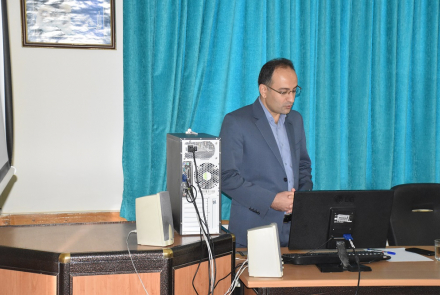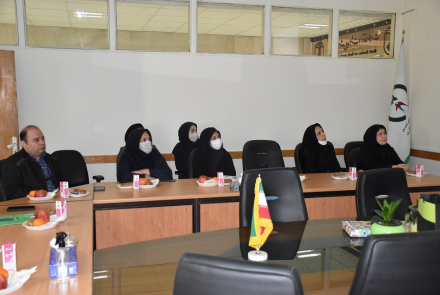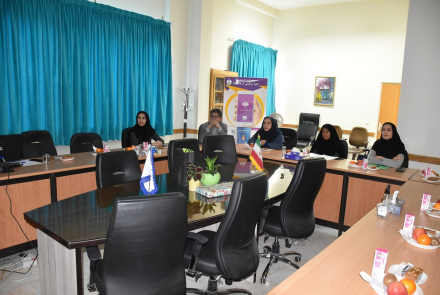دفاع پایان نامه دکتری آموزش بهداشت و ارتقاء سلامت آقای رحمت چتری پور
چهارشنبه 16 آذر 1401 رحمت چتری پور از پایان نامه خود با عنوان" طراحی و ارزشیابی برنامه آموزشی مبتنی بر پروتکل نقشه نگاری مداخله(IM) در رفتارهای خود مراقبتی چشم در دانشجویان"با راهنمایی دکتر مریم عمیدی مظاهری و مشاوره اساتید :دکتر افسانه نادری بنی،دکتر آوات فیضی و دکتر فرشته زمانی دفاع نمودند.
چکیده
مقدمه : سلامت بینایی یک عامل مهم و تاثیرگذار بر کیفیت زندگی افراد است. بروز هر گونه نقص در سلامت چشمها میتواند زمینه ساز مشکلات عدیده دیگری در زندگی افراد شود. بنابراین با توجه به میزان شیوع اختلالات و مشکلات چشمی در جوامع مختلف، بکارگیری روشهای موثرتر برای اتخاذ رفتارهای حفاظت کننده از سلامت چشمها ضروری است. مطالعه حاضر با هدف طراحی و ارزشیابی برنامه آموزشی مبتنی بر پروتکل نقشه نگاری مداخله (IM) در رفتارهای خودمراقبتی چشم در دانشجویان دانشگاه علوم پزشکی اصفهان انجام شد.
مواد و روشها: این مطالعه ترکیبی به صورت متوالی اکتشافی، در دو فاز در دانشگاه علوم پزشکی اصفهان انجام شد. فاز اول شامل شش گام برای طراحی برنامه آموزشی مبتنی بر پروتکل IM بود. درگام اول، طی یک مطالعه کیفی به روش تحلیل محتوی با مشارکت دانشجویان و مراقبین تخصصی چشم و مرور سیستماتیک متون علمی، رفتارهای خودمراقبتی چشم و تعیینکنندههای اصلی آن شناسایی شد. درگام دوم؛ تعیینکنندهها و اهداف تغییر برنامه خودمراقبتی چشم، و الگوی منطقی تغییر ترسیم شد. طی گام سوم؛ ایدههای برنامه آموزشی، روشهای نظری مناسب و قابل کاربرد برای بیشترین تاثیرگذاری انتخاب شدند. درگام چهارم؛ اجزا و مواد برنامه انتخاب شد و توسط تیم پیش آزمون کننده مورد ارزیابی قرار گرفت. طی گام پنجم؛ برنامه ریزی اجرای برنامه مداخله خودمراقبتی چشم انجام شد. در نهایت در گام ششم؛ جهت برنامه ریزی ارزشیابی براساس یافتههای گامهای قبل؛ دو ابزار سنجش عوامل رفتاری و تعیینکنندهها شناختی خود مراقبتی چشم تدوین شد. پس از سنجش روایی صوری و محتوی ابزار ها، طی یک مطالعه مقطعی روایی سازه با استفاده از فاکتور آنالیز مورد سنجش قرار گرفت. پایایی درونی و بیرونی ابزارها به ترتیب با استفاده از روش آلفای کرونباخ و آزمون – باز آزمون محاسبه شد.
در فاز دوم مطالعه، جهت ارزیابی تاثیر مداخله آموزشی؛ دانشکدههای دانشگاه علوم پزشکی اصفهان به شیوه تصادفی به دو گروه مداخله و شاهد تخصیص داده شدند، سپس به تناسب حجم مقاطع تحصیلی به کل نمونه، نمونهگیری به شیوه تصادفی انجام شد(هر گروه 105 نفر)، و دادههای پیش آزمون گردآوری شد. مداخله آموزشی تنها برای دانشجویان گروه مداخله، با استفاده از نرم افزار کاربردی(app) تولید شده و پیامهای آموزشی انجام گرفت. سپس در سه و شش ماه بعد مداخله؛ مجددا دانشجویان هر دو گروه مداخله و شاهد ابزارهای سنجش عوامل رفتاری و تعیینکنندههای شناختی خودمراقبتی چشم را تکمیل کردند. دادهها با استفاده از نرم افزار ر SPSS24 تجزیه و تحلیل شدند P-value .کمتر از 05/0 از لحاظ آماری معنادار در نظر گرفته شد.
یافتهها: در فاز اول این مطالعه، برنامه خودمراقبتی چشم و ابزارها برای سنجش عوامل رفتاری و تعیینکنندههای شناختی طراحی شد. که نتایج آن در قالب شش گام پروتکل IM ارائه شده است. بر اساس مطالعه کیفی سه طبقه اصلی و تعیینکنندههای اصلی خودمراقبتی چشم (خودتنظیمی- خودکارآمدی درکشده، انتظار پیامد، موانع درکشده، انگیزش، حساسیت درکشده، باورهای هنجاری، شدت درکشده) به دست آمد. اجزا و مواد برنامه آموزشی در قالب نرم افزار کاربردی(app) مبتنی بر نتایج گامهای IM تولید شد. ابزار سنجش عوامل رفتاری با 37 گویه شامل سه عامل بود، که پایایی درونی آن براساس آلفای کرونباخ 874/0 و دامنه پایایی بیرونی عاملها براساس ICC804/0- 928/0، بدست آمد. همچنین ابزار تعیینکنندهای شناختی شامل 39 گویه و هفت عامل استخراجی بود، که پایایی درونی 78/0 و دامنه پایایی بیرونی عاملها برای این ابزار 787/0- 906/0 بدست آمد.
یافته های فاز دوم مطالعه(مداخله) نشان داد؛ میانگین نمره هریک ازعوامل رفتاری و عوامل شناختی در قبل از مداخله در دو گروه مورد و شاهد تفاوت معنادار آماری نداشتند(P-value≥0.05). اما بعد از مداخله آموزشی، مقایسه میانگین تغییرات عامل رفتارهای مرتبط با صفحات نمایش، و عامل خودتنظیمی - خودکارآمدی درک شده، در طول دوره مداخله بین دو گروه(مداخله و کنترل) حاکی از تفاوت معناداری بود(P-value<0.05)، که برای این دو عامل معناداری آماری در دو مقطع زمانی سه و شش ماه بعد مداخله بین دو گروه وجود داشت(P-value<0.05). تغییرات میانگین نمره سایر عوامل درگروه مورد بیشتر از گروه کنترل بود اما تغییرات معنادار آماری در برخی از حالات رخ داد.
نتیجهگیری: نتایج بخش کیفی مطالعه طبقهبندی جدیدی از رفتارها، اداراکات و تعیینکنندههای اصلی مرتبط با برنامه خودمراقبتی چشم را نشان داد که میتواند علت بسیاری از رفتارهای نادرست در رابطه با خودمراقبتی چشم در دانشجویان باشد. پس از مداخله آموزشی با نرم افزار کاربردی درک دانشجویان از وخامت مشکلات ناشی از بینایی با پیامهای مناسب تغییر یافته بود و پذیرش پیامهای مناسب در گذر زمان به فراموشی سپرده نشده بود. همچنین نتایج تحقیق، تاثیر پیامهای مرتبط با خودکارآمدی درکشده و خودتنظیمی در این زمینه را بیشتر نشان دادند. بنابراین میتوان با هزینه اندک مداخله آموزشی در قالب نرم افزار کاربردی مناسب و در نتیجه نهادینهکردن رفتار خودمراقبتی چشم، از مشکلات بینایی دانشجویان و صرف هزینه های سنگین مستقیم و غیر مستقیم مرتبط با آنها پیشگیری نمود.
کلیدواژهها: خودمراقبتی، چشم، پروتکل نقشه نگاری مداخله، مداخله آموزشی، دانشجویان، مطالعه ترکیبی
Designing and Evaluating an Educational Program Based on the Intervention Mapping (IM) Protocol for Eye Self-Care Behaviors in Students
Abstract
Introduction: Vision health is a significant indicator of an individual's quality of life. Any eye health defect can result in many additional challenges in an individual's life. Given the prevalence of eye disorders and conditions in various societies, employing more effective measures to enhance eye-health-promoting behaviors is necessary. The purpose of the present study was to design and assess an educational program based on the intervention mapping (IM) protocol for eye self-care behaviors among Isfahan University of Medical Sciences students.
Methods: The present mixed-methods study at Isfahan University of Medical Sciences had an exploratory sequential design and was conducted in two phases. The first phase consisted of six design steps for an educational program based on the IM protocol. In the first step, eye self-care behaviors and their main determinants were identified through a qualitative study employing content analysis with the participation of students and specialized eye caregivers, as well as a systematic review of scientific texts. In the second step, the determinants and objectives of the eye self-care program change and the logical model of change were outlined. The third step involved selecting educational program concepts and applicable and appropriate theoretical methods for maximum effect. The pre-test team selected and evaluated the program's components and content in the fourth step. In the fifth step, the eye self-care intervention program was planned, and in the sixth step, two tools for measuring behavioral factors and cognitive determinants of eye self-care were developed to plan the evaluation based on the findings of the previous steps. After assessing the tools' face and content validity, a cross-sectional study assessed construct validity using factor analysis. Cronbach's alpha and test-retest methods were employed to calculate the tools' internal and external reliability, respectively. In the study's second phase, Isfahan University of Medical Sciences faculties were randomly assigned to intervention and control groups to evaluate the impact of the educational intervention. Then, random sampling was conducted based on the ratio of the number of educational grades to the total sample size (105 samples per group), and pre-test data were subsequently collected. Only students in the intervention group used the application (app) and educational messages during the educational intervention. Three and six months after the intervention, students in both the intervention and control groups re-completed the instruments for measuring behavioral and cognitive determinants of eye self-care. SPSS (v. 24) was used to analyze the data, and a P-value < 0.05 was considered statistically significant.
Results: An eye self-care program and tools were designed to measure behavioral factors and cognitive determinants in the study's first phase. The results were presented in six IM protocol steps. Based on the qualitative study, three main categories and key determinants of eye self-care were identified (perceived self-regulation- self-efficacy, outcome expectancy, perceived barriers, motivation, perceived susceptibility, normative beliefs, and perceived severity). Based on the IM results, the educational program components and content were generated in an application (app). The tool for measuring behavioral factors with 37 items contained three factors, the internal reliability of which was equal to 0.874 based on Cronbach's alpha, and the external reliability range of the factors was between 0.804 and 0.928 based on ICC. The tool for cognitive determinants comprised 39 items and seven extractable factors, with internal reliability of 0.78 and an external reliability range of 0.787-0.906. Before the intervention, there was no statistically significant difference in the mean scores of behavioral and cognitive factors between the case and control groups (P-value ≥ 0.05), according to the findings of the second phase (intervention). However, a comparison of the mean changes in screen-related behavior and perceived self-efficacy-self-regulation revealed a statistically significant difference between the two groups (intervention and control) after the educational intervention (P-value < 0.05), and there was statistical significance for the two factors between the two groups at three and six months after the intervention (P-value < 0.05). The mean score changes of other factors were greater in the case group than in the control group, but the differences were statistically significant in some instances.
Conclusion: The qualitative phase of the study revealed a new classification of behaviors, perceptions, and main determinants related to the eye self-care program, which may cause several incorrect student behaviors regarding eye self-care. Appropriate messages changed the student's perceptions of the severity of vision problems after the educational intervention with the app, and the acceptance of the targeted messages was not neglected over time. The results of this study indicated that messages relating to perceived self-efficacy and self-regulation have a greater impact in this field. Therefore, it is possible to prevent students' vision problems and their high direct and indirect costs with a low-cost educational intervention in the form of suitable apps, thereby institutionalizing eye self-care.
Keywords: Eye Self-Care, Intervention Mapping (IM) Protocol, Educational Program, Students, mixed-methods study, Validity, Reliability




